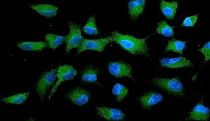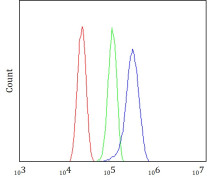ARG43626
anti-ATG9A antibody
anti-ATG9A antibody for Flow cytometry,ICC/IF,Western blot and Human,Mouse
Cancer antibody; Cell Biology and Cellular Response antibody; Cell Death antibody; Metabolism antibody; Neuroscience antibody
Overview
| Product Description | Rabbit Polyclonal antibody recognizes ATG9A |
|---|---|
| Tested Reactivity | Hu, Ms |
| Tested Application | FACS, ICC/IF, WB |
| Host | Rabbit |
| Clonality | Polyclonal |
| Isotype | IgG |
| Target Name | ATG9A |
| Antigen Species | Human |
| Immunogen | Recombinant fragment within a.a. 1-820 of Human ATG9A. |
| Conjugation | Un-conjugated |
| Protein Full Name | Autophagy-related protein 9A |
| Alternate Names | APG9L1; MGD3208; APG9-like 1; mATG9; Autophagy-related protein 9A |
Application Instructions
| Application Suggestion |
|
||||||||
|---|---|---|---|---|---|---|---|---|---|
| Application Note | * The dilutions indicate recommended starting dilutions and the optimal dilutions or concentrations should be determined by the scientist. | ||||||||
| Positive Control | A375 | ||||||||
| Observed Size | 94-120 kDa |
Properties
| Form | Liquid |
|---|---|
| Purification | Affinity purification with immunogen. |
| Buffer | 0.9% NaCl, 0.2% Na2HPO4, 0.01% Sodium azide and 4% Trehalose. |
| Preservative | 0.01% Sodium azide |
| Stabilizer | 4% Trehalose |
| Concentration | 0.5 mg/ml |
| Storage Instruction | For continuous use, store undiluted antibody at 2-8°C for up to a week. For long-term storage, aliquot and store at -20°C or below. Storage in frost free freezers is not recommended. Avoid repeated freeze/thaw cycles. Suggest spin the vial prior to opening. The antibody solution should be gently mixed before use. |
| Note | For laboratory research only, not for drug, diagnostic or other use. |
Bioinformation
| Database Links | |
|---|---|
| Gene Symbol | ATG9A |
| Gene Full Name | autophagy related 9A |
| Background | Acts upstream of or within autophagosome assembly. Located in endosome; phagophore assembly site; and trans-Golgi network. [provided by Alliance of Genome Resources, Apr 2022] |
| Function | Involved in autophagy and cytoplasm to vacuole transport (Cvt) vesicle formation. Plays a key role in the organization of the preautophagosomal structure/phagophore assembly site (PAS), the nucleating site for formation of the sequestering vesicle. Cycles between a juxta-nuclear trans-Golgi network compartment and late endosomes. Nutrient starvation induces accumulation on autophagosomes. Starvation-dependent trafficking requires ULK1, ATG13 and SUPT20H. [UniProt] |
| Cellular Localization | Cytoplasmic vesicle, autophagosome membrane; Multi-pass membrane protein. Golgi apparatus, trans-Golgi network membrane; Multi-pass membrane protein. Late endosome membrane; Multi-pass membrane protein. Endoplasmic reticulum membrane; Multi-pass membrane protein. Note=Under amino acid starvation or rapamycin treatment, redistributes from a juxtanuclear clustered pool to a dispersed peripheral cytosolic pool. The starvation- induced redistribution depends on ULK1, ATG13, as well as SH3GLB1 |
| Research Area | Cancer antibody; Cell Biology and Cellular Response antibody; Cell Death antibody; Metabolism antibody; Neuroscience antibody |
| Calculated MW | 94 kDa |
| PTM | Acetylation; Glycoprotein; Phosphoprotein |
Images (3) Click the Picture to Zoom In
-
ARG43626 anti-ATG9A antibody ICC/IF image
Immunofluorescence: A549 cells were stained with ARG43626 anti-ATG9A antibody 1:100 and 4°C. DAPI (blue) was used as the nuclear counter stain.
-
ARG43626 anti-ATG9A antibody WB image
Western blot: K562, MCF7 and A375 cells lysates stained with ARG43626 anti-ATG9A antibody at 1:5000 dilution.
-
ARG43626 anti-ATG9A antibody FACS image
Flow Cytometry: U87 cells were stained with ARG43626 anti-ATG9A antibody (Blue) at 1:500 dilution (1x10^6 cells). Unlabelled sample (Red) was used as a control.








